
For this edition of Classic Steel, we are going to take a look back at the shootout rankings for the 125 class of 1986.

People love shootouts and in 1986 we had four of them to narrow down the best 125 in the land.
The eighties were a great time for motocross. Tracks were plentiful, bikes were relatively cheap, and innovation was the name of the game. Motocross technology was moving at light speed and riders were the beneficiaries of those advancements. By 1986, all the machines in the 125 class featured liquid-cooling, some sort of “power valve,” front disc brakes, and long-travel single-shock rear suspensions. Even the poorest performers of the ’86 125 class would have handily beaten the best machines from only a few years before. Motocross in the 80s was a cutthroat business and in no class was that more apparent than in the 125s.
For this retrospective, we are once again going to take a look back at the contenders through their rankings in the major (American) enthusiast magazines of the time. In this case, that means Motocross Action, Dirt Bike, Cycle World, and Cycle News. For some reason that defies my understanding, Dirt Rider, which was one of the most popular magazines available in 1986, chose to not even have a 125 shootout in 1986. Considering how popular these shootouts were with readers, I can only assume someone at the magazine had a really bad concussion when they were pitching story ideas. Oh well, we can only cover what they covered, so Dirt Rider will have to sit this one out.
Just like previous lookbacks, I am going to list the final rankings for each bike and give a brief synopsis of its strengths and weaknesses. If a machine was not tested by all the magazines, I am going to only list the rankings that apply. Here is the 125 class of 1986 as seen through the motorcycle magazines of the time.
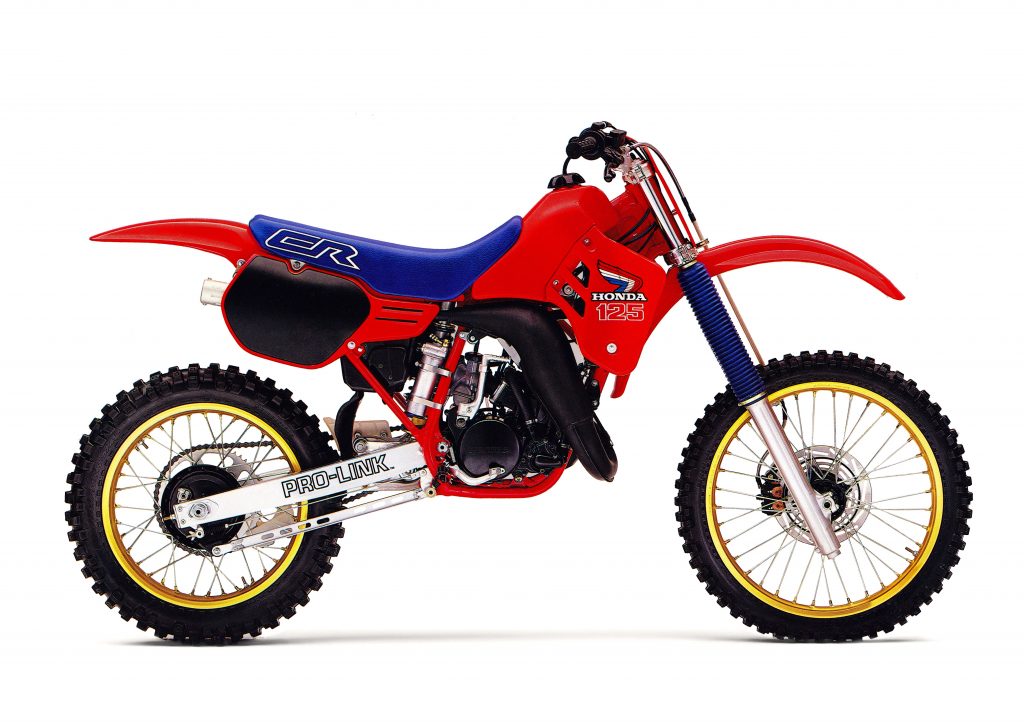
1986 Honda CR125R Shootout Rankings: MXA – 1st (out of 4) Dirt Bike – 1st (out of 5) Cycle World – 1st (out of 6) Cycle News – 1st (out of 4) Photo Credit: Honda
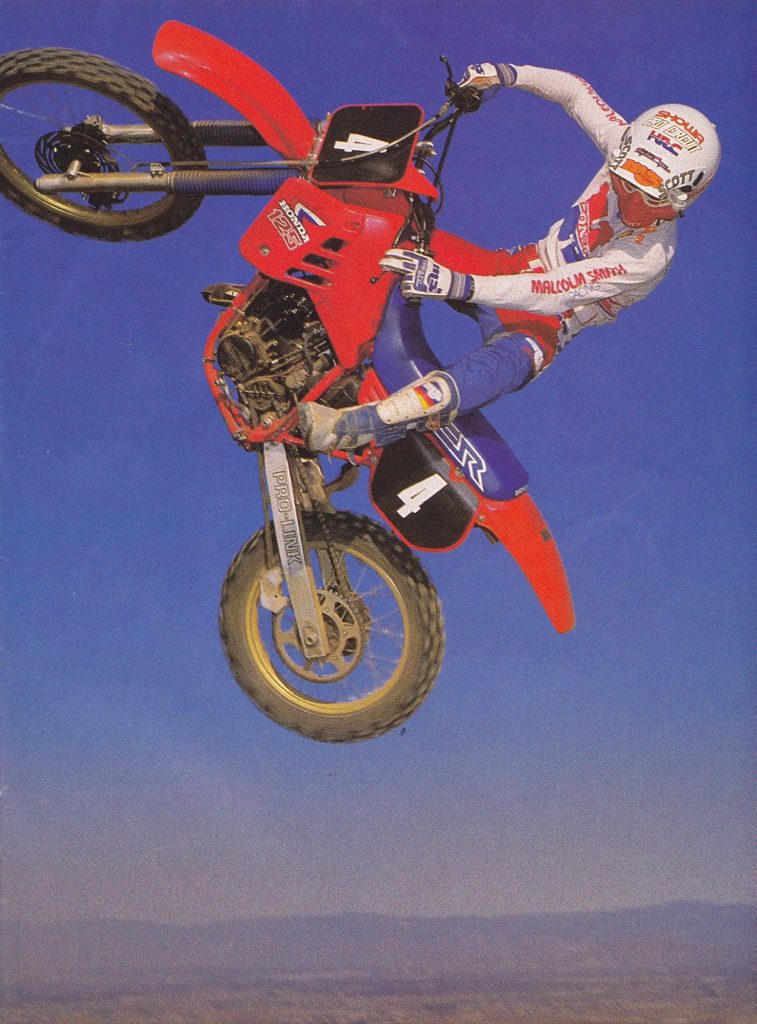
In 1986, Honda hit the jackpot with a lineup of machines that dominated in the magazines and on the track. Photo Credit: Dirt Bike
1986 Honda CR125R Overview: In 1986, if you were riding anything other than a Honda, you were truly at a major disadvantage. Pretty much across the board, the CRs were the best bikes available. In the 500 class the lead was less defined, but in every other division, the red machines ruled supreme. In the case of the ’86 Honda CR125R, that lead came mostly from its broad and potent motor package.
In 1985, the CR125R’s motor had been a mid-pack performer, but subtle changes for ’86 yielded major gains on the track. A redesigned cylinder maintained the ATAC design of ’84-’85 but added new porting to boost bottom-end response. A new single-ring piston was installed and matched with a beefed-up clutch for better hook-up. The chassis and bodywork remained largely unchanged, but the Pro-Link rear suspension received a revised ratio and a new Travel Control Valve was added to the 43mm Kayaba conventional forks. Unlike its larger siblings, the 125 did not get the benefit of Showa’s revolutionary new cartridge forks and had to make do with damper-rods for one more year.
On the track, the CR125R was the class of the 1986 125 field. It offered the most power and the broadest spread, with a beefy (for a 125) low-to-mid blast that barked out of turns and pulled the red machine to the front. The top end was only average, but by then the competition was in your dust. Turning was excellent and the Honda excelled at anything other than fifth-gear straights. Here, the CR got a little sketchy and the bike was not well suited for bombing across the desert at warp factor ten.
The suspension was adequate, but not spectacular by any means. Both the forks and shock garnered middle-of-the-pack ratings and no one loved either end’s performance. Thankfully, none of its competitors were particularly good either in 1986 and the Honda’s mediocre suspension showings were not enough to torpedo its rankings at the front. The CR ran the best, shifted the best, clutched the best, turned the best, and felt the best. It was also drop-dead gorgeous, but I don’t think that helped it in the final standings. In the end, it ranked first in every shootout and it was not even close. In the 125 class, motor has always been King, and in ’86, the bike wearing that crown was the CR125R.
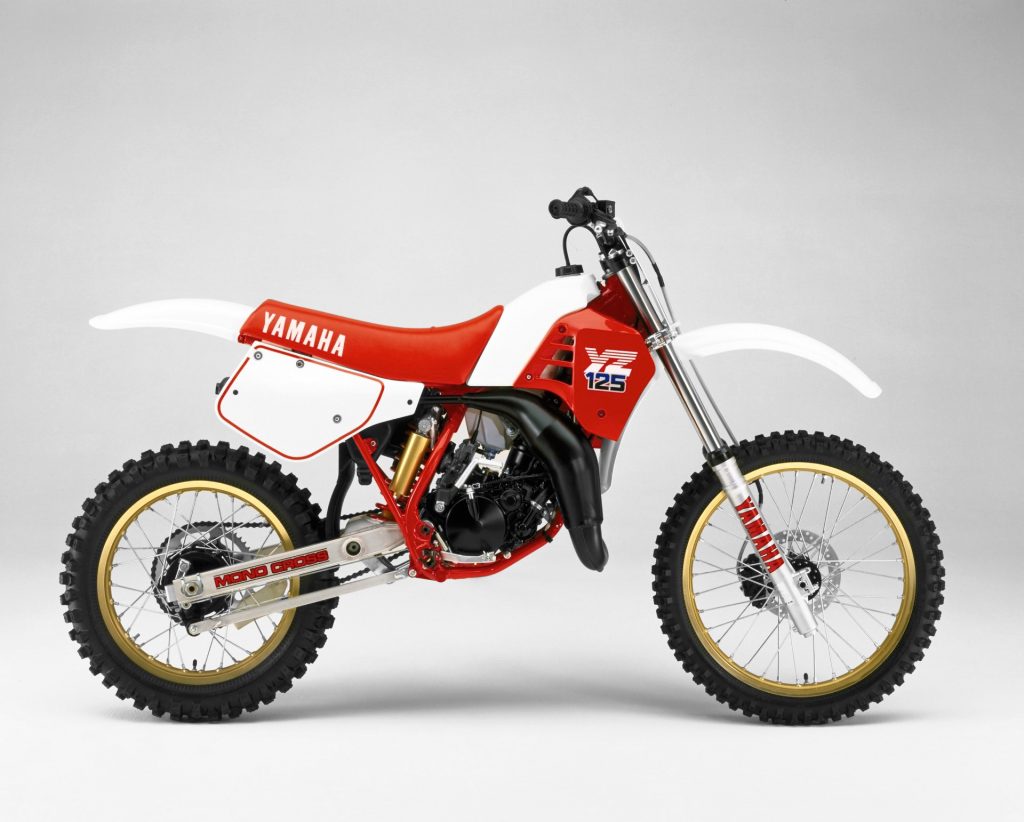
1986 Yamaha YZ125 Shootout Rankings: MXA – 2nd (out of 4) Dirt Bike – 2nd (out of 5) Cycle World – 3rd (out of 6) Cycle News – 2nd (out of 4) Photo Credit: Yamaha
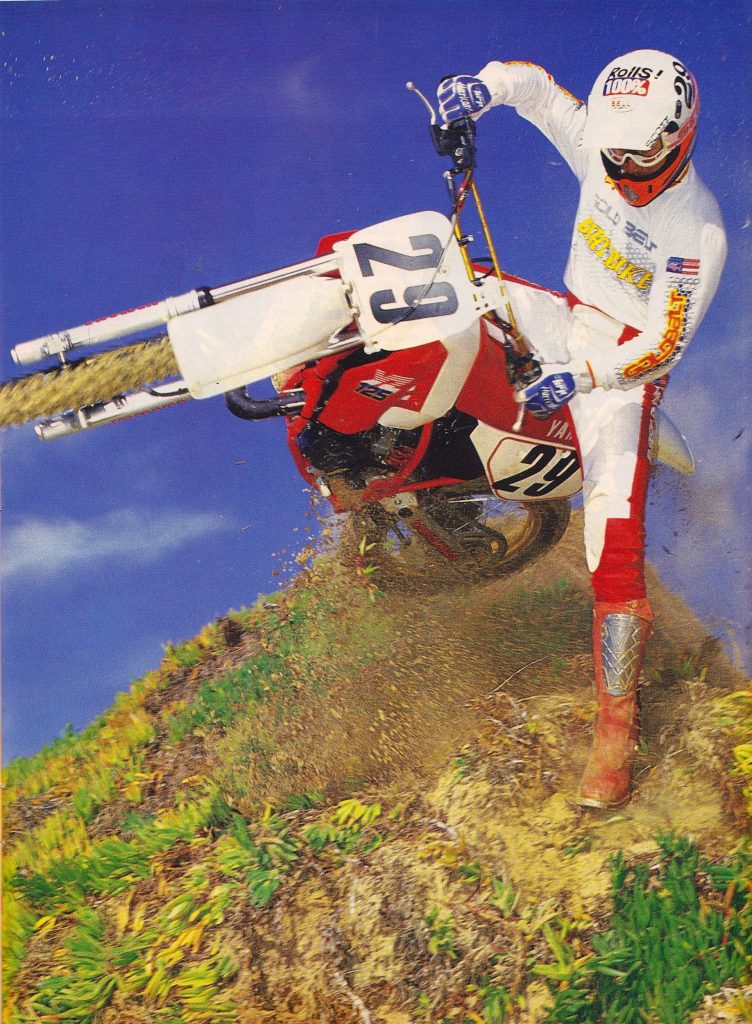
With an all-new motor and redesigned chassis the YZ125 offered a huge upgrade in performance in 1986. Photo Credit: Dirt Bike
1986 Yamaha YZ125 Overview: Long the whipping boy of the 125 class, Yamaha’s YZ125 finally did some whipping of its own in 1986. An all-new case-reed motor brought a much-needed boost to the former weakling of the class. The new mill provided a super-strong low-to-mid blast but absolutely no top-end whatsoever. Out of turns, it was a rocket, but you had to be fast on the shifter to keep it from falling off the pipe. Unfortunately, that was no easy task with the Yamaha’s cranky clutch and notchy transmission. Under power, it was impossible to shift without backing off slightly and feeding in some clutch. It was by far the worst transmission in the class and a major handicap to an otherwise very competitive motor package.
On the chassis side, the new YZ was much improved over 1985. The new YZ turned much better than before (but not as well as the Honda) and offered the best stability in the class. Everyone loved the slim new bodywork and sano looks as well. The forks tied the Honda for mid-pack but the new Öhlins-type KYB shock swept the field with excellent performance. Overall, it was a clutch and transmission away from challenging the Honda at the front. After several years of being compared to snails, lawnmowers, and mopeds, this breakthrough in performance was a welcome change for the tuning fork crew.
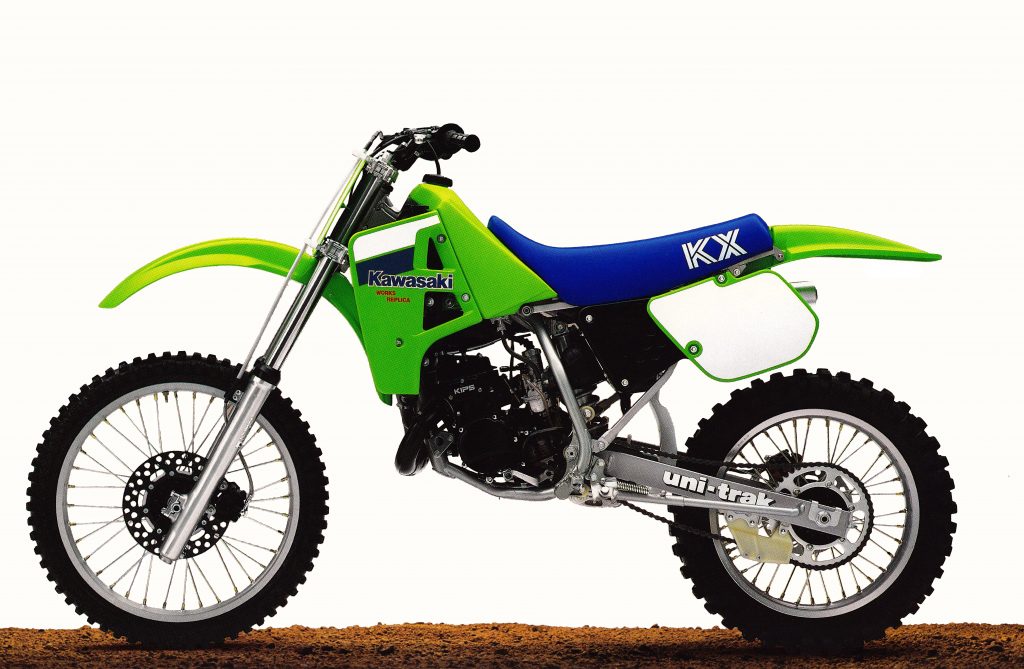 1986 Kawasaki KX125 Shootout Rankings: MXA – 3rd (out of 4) Dirt Bike – 3rd (out of 5) Cycle World – 2nd (out of 6) Cycle News – 4th (out of 4) Photo Credit: Kawasaki
1986 Kawasaki KX125 Shootout Rankings: MXA – 3rd (out of 4) Dirt Bike – 3rd (out of 5) Cycle World – 2nd (out of 6) Cycle News – 4th (out of 4) Photo Credit: Kawasaki
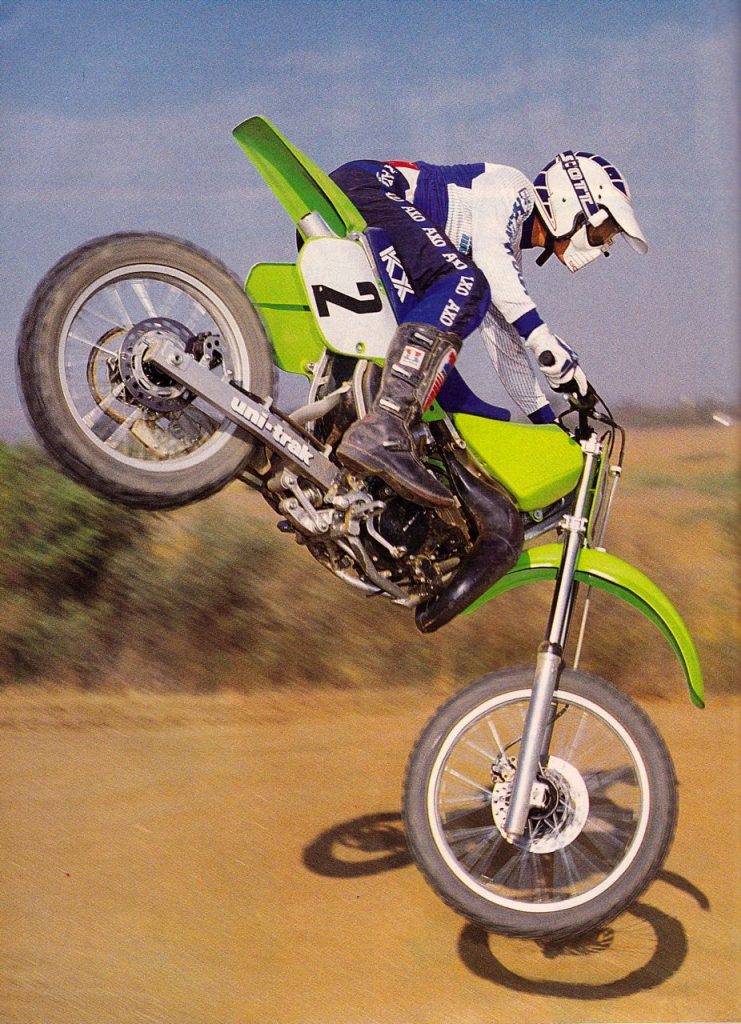
Kawasaki went for horsepower in 1986 and it backfired with a narrow powerband that was far harder to use than the class-leading 1985’s had been. Photo Credit: Dirt Bike
1986 Kawasaki KX125 Overview: In 1984 and 1985 the Kawasaki KX125 had been the class of the 125 field with a romp n’ stomp n’ motor and workman-like chassis. The KX offered by far the best power in the class and that was more than enough to outclass its rivals. For 1986, Kawasaki threw out the baby with the bathwater and introduced an all-new machine. The new “Works Replica” KX125 featured a completely redesigned chassis that removed the “dog-bone” strut and replaced it with a more conventional bottom-link Uni-Trak design. The motor, bodywork, and brakes were all new as well, adding a works-style rear disc binder for the first time.
On paper, the new KX looked damn impressive, but on the track it proved underwhelming. Unlike the ’85, the new motor proved peaky and hard to ride. In an interesting twist, the Honda and Kawasaki switched powerbands for ’86, with the new CR getting the ’85 KX’s meaty pull and the Kawasaki receiving the old Honda’s lackluster grunt and endless rev. For pros like Eddie Warren, this was probably a fair tradeoff, but for regular Joes, this was not a welcome change. Now the KX required a go-for-broke attack style on the track to keep from falling off the pipe and riders of lesser skill found the new powerband too demanding.
On the chassis side, the KX received further demerits for its utter unwillingness to turn and a confused rear shock. The bike felt like it had a hinge in the middle with the front wheel not communicating your intention to turn to the rest of the chassis. The forks worked well enough compared to its rivals (again, none of them were good in 1986) but the shock was busy, harsh, and choppy in the rough. Riders loved the super-powerful rear disc once they got used to it and it was probably the single best feature on the KX125 in 1986. After two years of dominating the class, the ’86 KX125 proved a huge disappointment for Kawasaki fans. If you had the skill to keep it cooking, it was a contender, but there were far easier tickets to the victory podium available in 1986. 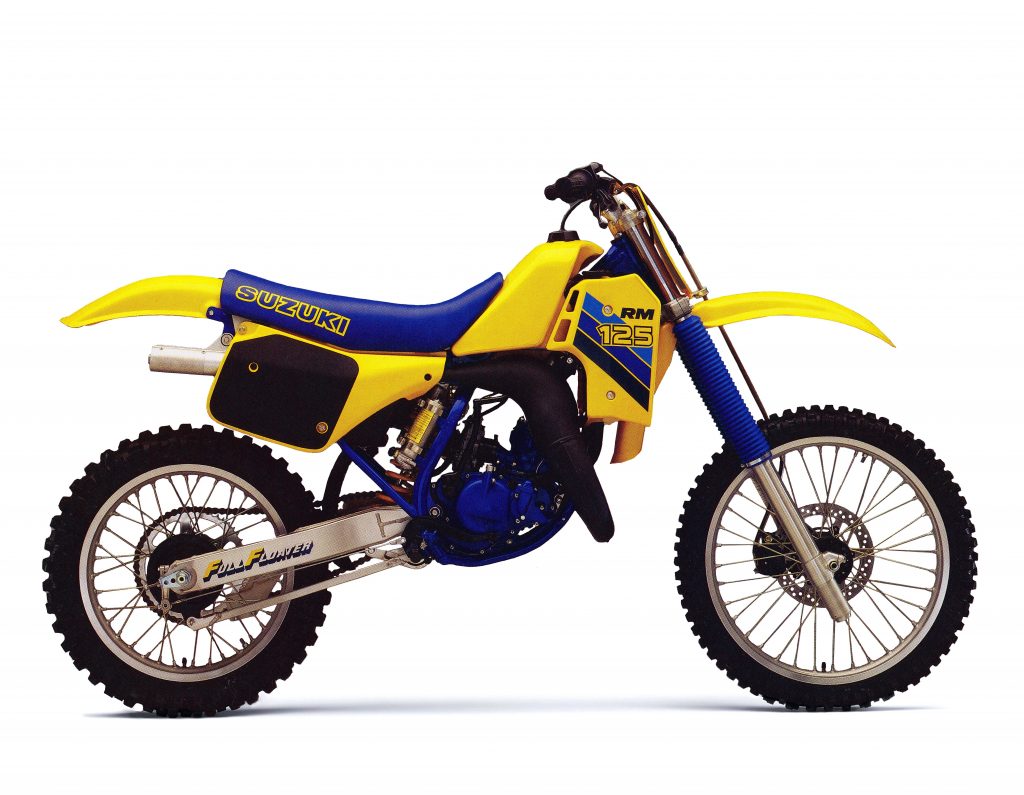 1986 Suzuki RM125 Shootout Rankings: MXA – 4th (out of 4) Dirt Bike – 5th (out of 5) Cycle World – 5th (out of 6) Cycle News – 3rd (out of 4) Photo Credit: Suzuki
1986 Suzuki RM125 Shootout Rankings: MXA – 4th (out of 4) Dirt Bike – 5th (out of 5) Cycle World – 5th (out of 6) Cycle News – 3rd (out of 4) Photo Credit: Suzuki
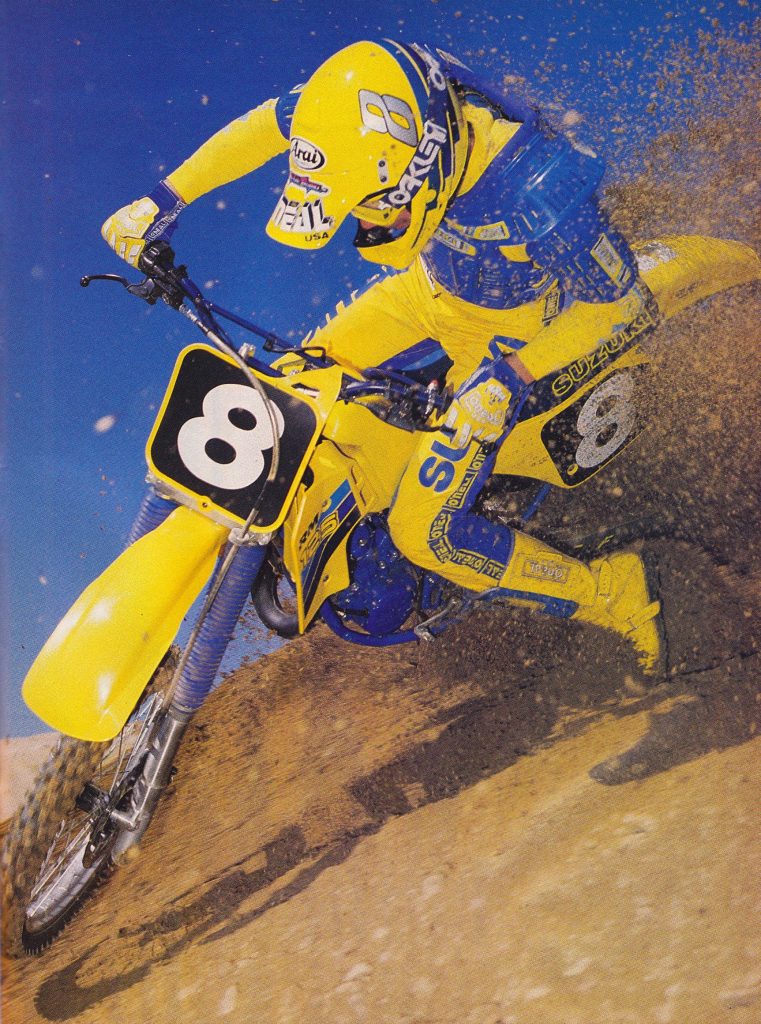
Riders like Erik Kehoe could make the RM125 sing but for most mere mortals the RM’s lack of torque made it an all-too-demanding machine to ride fast. Photo Credit: Suzuki
1986 Suzuki RM125 Overview: Like the Yamaha and Kawasaki, the Suzuki RM was all-new for 1986. Despite its rather old-fashioned appearance, the bike was a complete redesign. An all-new chassis, motor, and suspension system graced the ’86, with a power valve making its appearance for the first time. This was also the first year that the original Full Floater was retired due to legal issues and packaging concerns.
On the track, the RM proved woefully outgunned in 1986. The new Automatic Exhaust Control (AEC) motor provided a listless and slow-revving delivery that made the bike incredibly difficult to ride fast. It was gutless down low, mediocre in the middle and middling on top. On the dyno, it put out nearly 20% less horsepower than the CR125R. People also hated its funky ergonomics, outdated looks, poor clutch, sub-par construction, and underpowered brakes. Pretty much the only things people did like were its forks, which were the best in a field of middling performers. The new non-floating Full Floater worked well at first but fell prey to tons of drag if not serviced constantly. Overall, it was a poor effort for the machine that had dominated small-bore racing throughout the seventies and early eighties. It finished last or second to last in every shootout and even got beat by the Cagiva in Dirt Bike and Cycle World’s contests. Unless you were on Suzuki’s payroll, there was no reason to go yellow in 1986.
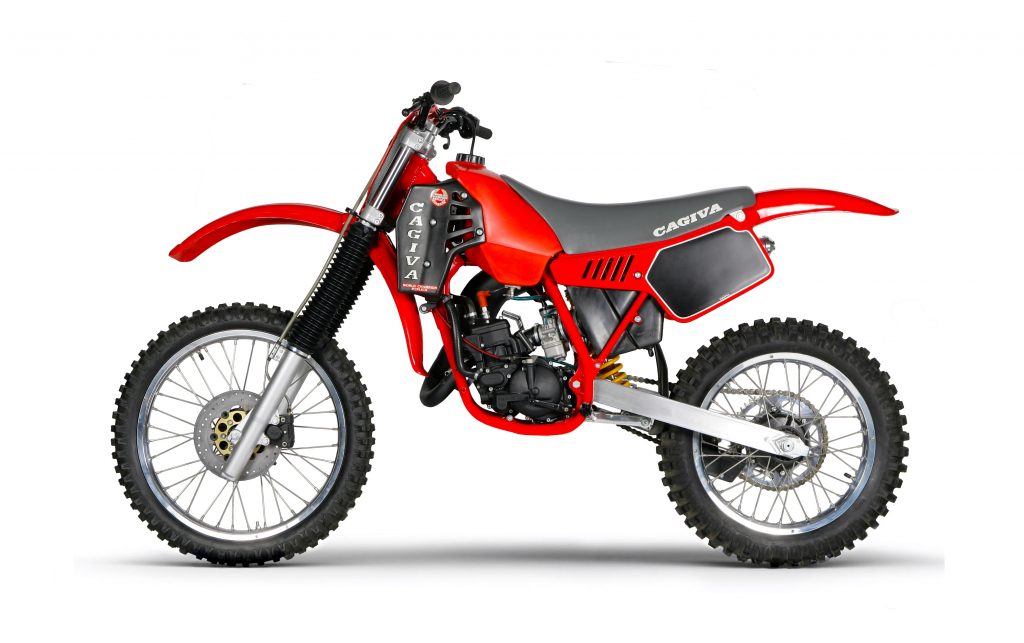 1986 Cagiva WMX 125 Shootout Rankings: MXA – N/A Dirt Bike – 4th
1986 Cagiva WMX 125 Shootout Rankings: MXA – N/A Dirt Bike – 4th
(out of 5) Cycle World – 4th (out of 6) Cycle News N/A Photo Credit: Stephan LeGrand
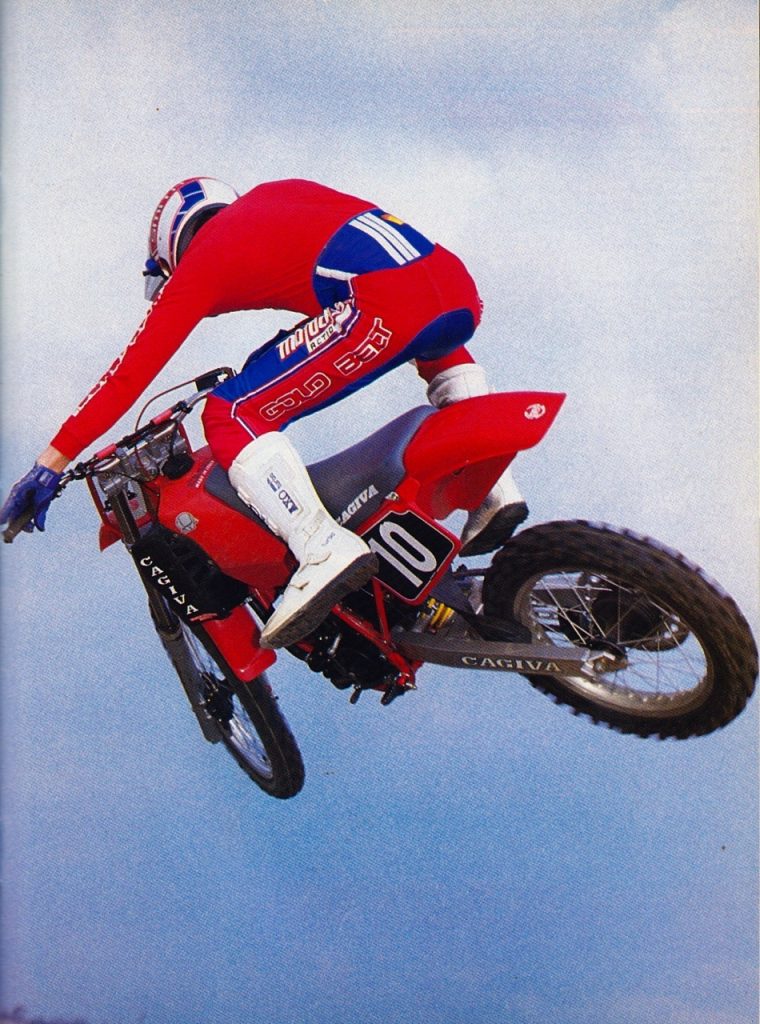
The World Championship Replica offered a potent power package in 1986 but its suspension settings held it back from running at the front. Photo Credit: Motocross Action
1986 Cagiva WMX 125 Overview: Cagiva made some major strides toward mainstream appeal in 1986. The brand was coming off of its first World Motocross title in 1985 and the ’86 WMX featured major upgrades in nearly every category. Its motor ran similarly to the new Yamaha with a potent low-to-mid power curve. Like the Yamaha, there was not much on top, but the Italian did offer a much less cranky transmission. Overall, it was the second-best 125 motor in 1986.
On the chassis side, the Cagiva offered a bit of a mixed bag. The frame handled well but the stock suspension was poor. The Marzocchi forks were harsh, prone to blowing seals and poorly set up. The shock was only slightly better and needed a re-valve to work properly. The brakes were also underpowered and required constant maintenance. The seat, while well-shaped, was hard as a slab of concrete and panned by testers.
With some careful setup, the Cagiva was certainly a contender, but it needed a complete suspension overhaul to reach its full potential. Even so, it was by far the most competitive European 125 offering up to that point and a machine worth considering if the ubiquitous Japanese tiddlers were not your type of thing.
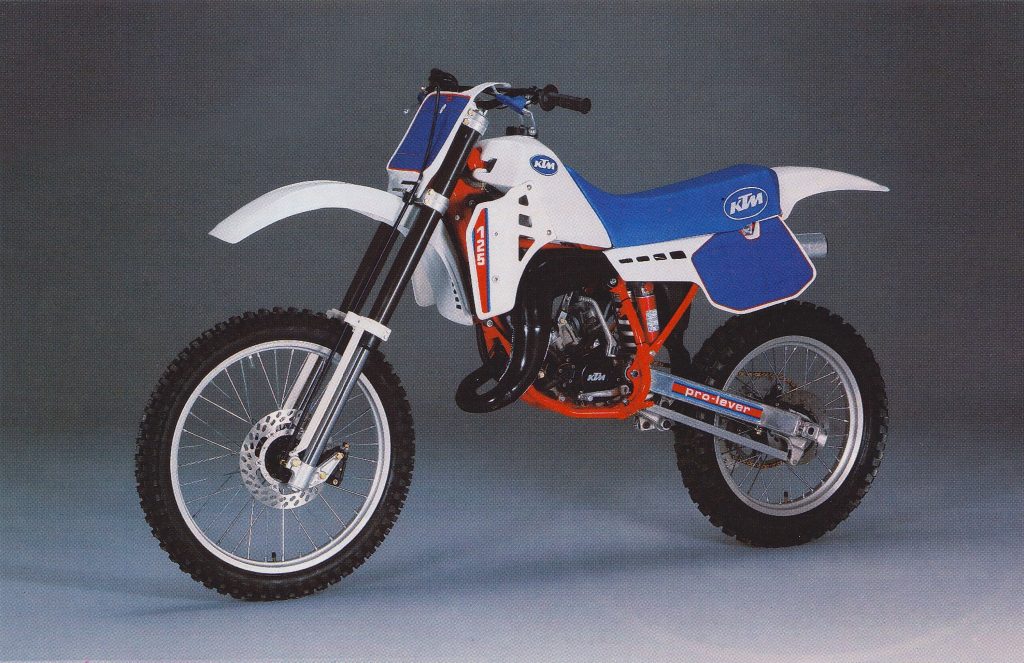 1986 KTM 125 Motocross Shootout Rankings: MXA – N/A Dirt Bike – N/A
1986 KTM 125 Motocross Shootout Rankings: MXA – N/A Dirt Bike – N/A
Cycle World – 6th (out of 6) Cycle News – N/A Photo Credit: KTM
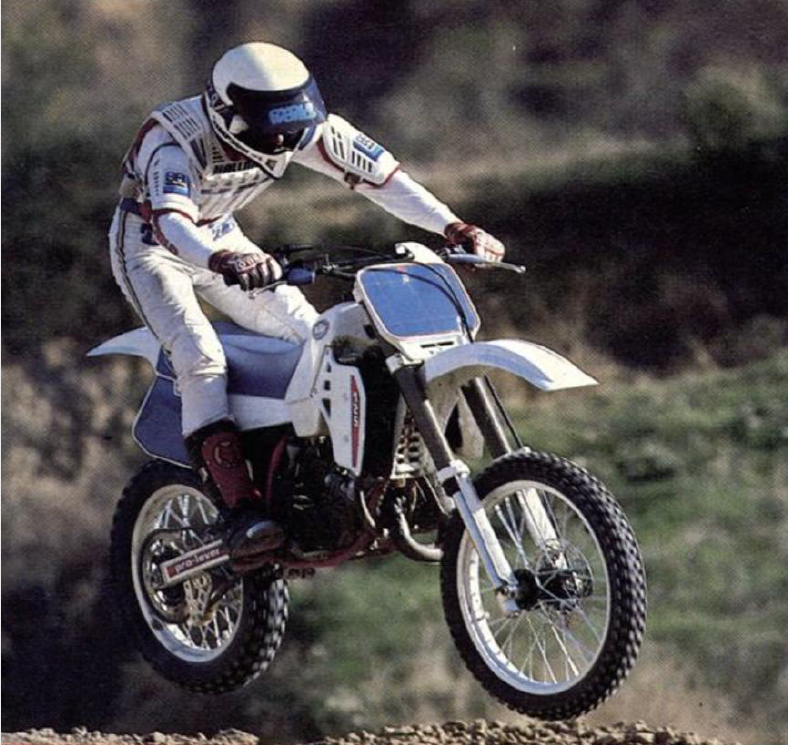
Advanced in many ways, but utterly out of step with the American market, KTM’s 125 was a bit player in the US in 1986. Photo Credit: Cycle World
1986 KTM 125 Motocross Overview: In 1986, the KTM 125 was one of the most technologically up-to-date machines in motocross. With its dual-disc brakes, inverted White Power forks, and case-reed motor, it was at the very cutting edge of 125 motocross design. It featured high-end suspension components, quality construction, and a unique European flair that either endeared you to it or put you off like the plague.
Despite its case-reed and power valve, the KTM offered by far the narrowest powerband of the ’86 125s. It was a midrange-only motor with virtually no power above or below its modest burst in the middle. Like the Yamaha, its transmission was a cantankerous affair that refused to shift under power and demanded precision to select the next cog. This made the Katoom incredibly hard to ride and far trickier to keep on the pipe than most of its rivals.
Like the Cagiva, its high-end European suspension components were set up for European tracks and completely out of step with American tastes of the time. As delivered, it tied the Cagiva for fork ineptitude and slam-dunked the competition for futility in the shock category. Considering these same units performed flawlessly on ATKs, it was clear that this was more a matter of improper setup than any real design flaws. Despite having a rear disc, the KTM’s brakes were rated back of the pack in performance. Both ends were weak, mushy, and numb-feeling.
On the bright side, the bike was the lightest in the class at a feathery 191 pounds. It also was very versatile with a large 2.6-gallon tank for off-road adventuring. While this did give it added range, some riders complained that the tank’s wide profile made the bike feel like an Enduro bike instead of a motocrosser. Like the Cagiva, the KTM cement seat led to premature monkey butt long before the Katoom exhausted its fuel supply.
Today, KTM dominates everything, but in 1986, they were the scrappy little guys from Mattighofen. It would take bankruptcy and over two decades for the Austrians to finally crack the code to motocross greatness. The fact that the KTM was not even included in any of the major shootouts in ’86 is a good indication of the respect KTM’s 125 program received at the time. Like all of these machines, the 125MX could have won in the right hands, but those hands had better have been damn talented to overcome the advantage the guy riding red already had in 1986.
So, there it is; the story of the 1986 125 class, viewed through the lens of the major enthusiast magazines of the day. If you enjoy these and would like to see me highlight another crop of machines, feel free to contact me on social media or leave a comment below.
For your daily dose of old school moto goodness, make sure to follow me on Instagram and Twitter @tonyblazier
For questions or comments, feel free to drop me a line anytime at TheMotocrossVault@Gmail.com




